A handful of wishful thinkers argue that the eye couldn’t “just happen”, and that it is proof of intelligent design. They’re half right.
Eyes didn’t just happen; in fact, they’re a perfect example of how the lengthy process of incremental random changes can amount to an intricacy and specialization that, at first glance, seems impossible.
But when it’s broken down, it isn’t too hard to imagine.
- Simple, light-sensitive proteins in the skin allowed unicellular organisms to follow light cycles of the day and night.
- Eyespots evolved into slightly cupped depressions in the skin, which changed the way angled light hit the cells. This allowed organisms to sense the direction of the light.
- With time, these cups evolved a protective skin layer, which developed into a lens. This improved images through media like water and air.
- Layers in these lens coverings split apart over time and housed clear fluid, improving the refractive power and the projection of the image.
- The light-receptive proteins developed differentiation between different frequencies of light, leading to colour vision and muscles developed around the organ, allowing light to be focused and the eyes to point in different directions.
- Eye placement migrated to the most beneficial: front-facing for predators and animals that jump between branches, and side-facing for those who need to look out for the former.
All of this happened with tiny, random mutations that were beneficial enough to give the host a better chance of survival. From there, eyes have diverged into low-light, precision organs, ultra colour vision sensors, or long-distance high-resolution zoom lenses.
There will of course be billions of unsung failures along this journey; changes that didn’t help, or made things harder. Those organisms would have struggled to breed and simply disappeared.
But those that brought about an advantage were locked into the DNA code and passed down to subsequent generations.
As we see from the fossil record, over the 555 million years of their evolution, eyes have been one of the most significant organs in the animal kingdom. And they come in a multitude of shapes and sizes.
Here are ten of the most impressive examples of animals with huge eyes that are some of the largest in the world, relative to their size and place in the animal kingdom.
10. Dragonflies
Dragonflies are some of the most outstanding winged animals on Earth. They can hover, fly backwards, and hunt on the wing with a kill accuracy that puts others to shame.
These are truly ancient predators, having ruled the skies back when vertebrates were still shaking off their sea legs. And their success is helped by a pair of enormous compound eyes.
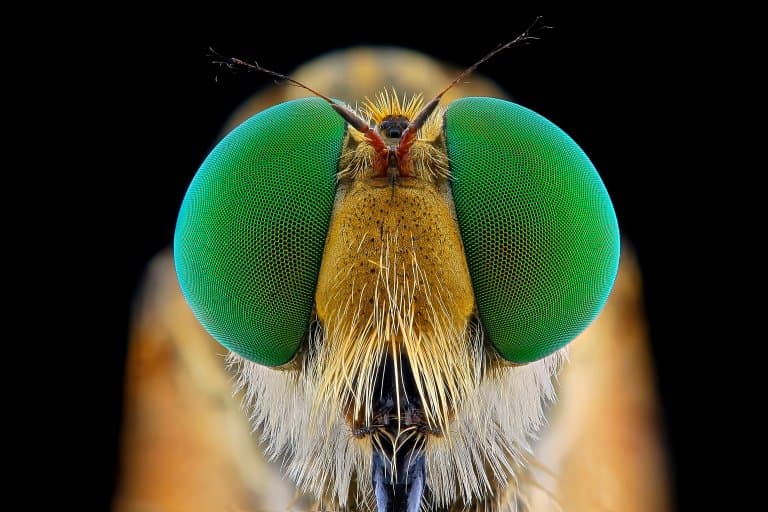
This eye contains up to 30 differential proteins to tell colour frequencies apart. For comparison, we have three. Dragonflies have the best colour vision of any known animal, and they make use of different spectra at different stages of their lives. 1
9. Tarsiers
In Southeast Asia, some of the smallest primates have the largest eyes. Tarsiers only really grow up to around 15cm (6 inches) long, but their eyes are disproportionally huge.
These big balls are designed to function in low light and are covered in light-sensitive cells. They’re so big, that they can’t be wiggled around in the skull like ours, so the tarsier needs to turn its whole head to look around.
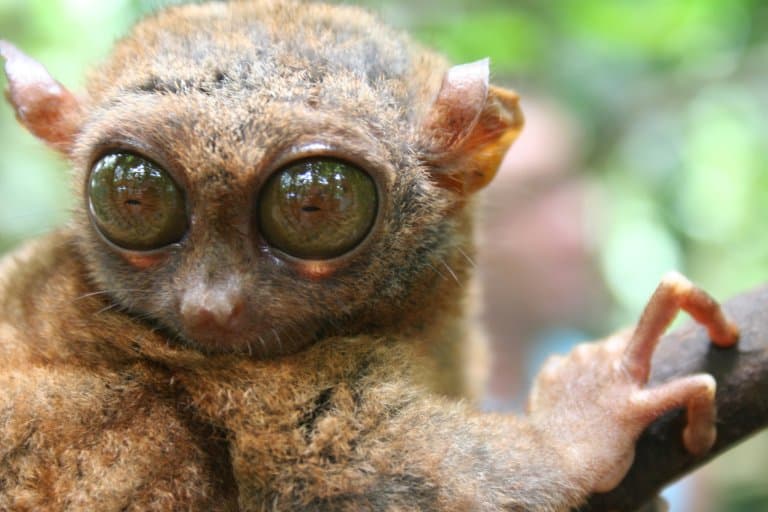
Proportionally, if humans had eyes this big, they’d be the size of grapefruits. These eyes are bigger than the animal’s brains, which can be quite a common theme, as we’ll see.
This animal is competing with another on this list for the biggest eyes relative to their body size and has the largest of any mammal. 2
8. Frogs
Of all vertebrate groupings, frogs might be the ones with the largest relative eye size. Aquatic and burrowing frogs seem to have smaller eyes, but the eyes of those who climb trees and hunt in the dark tend to be substantially larger.
When researchers investigated eye size in frogs it was a bit of a surprise just how large they are.
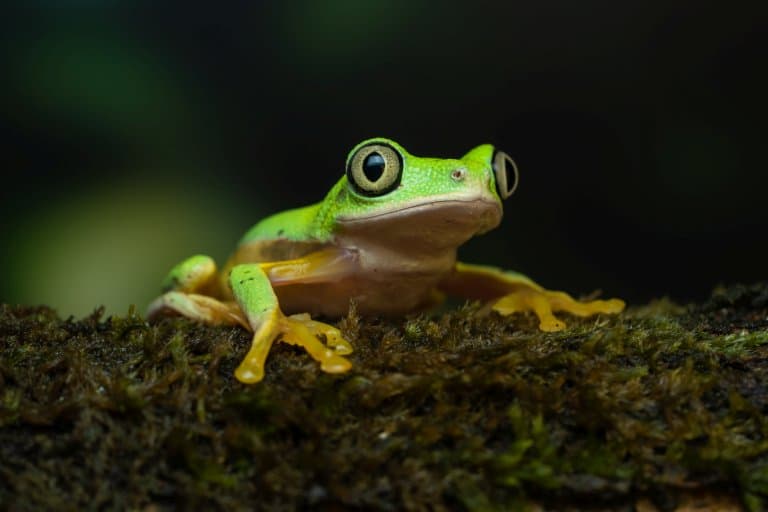
While birds are well known for having excellent vision and enormous eyes, frogs apparently were a bit neglected in the field, but this wasn’t always the case.
When scientists were studying eyes in the early days of biological sciences, frogs were a common test subject, but their presence in the field was eventually replaced by birds.
Recent revivals in amphibian research are illuminating the significance of frog vision, and how it has evolved independently in vertebrate lines, as well as just how impressive these animals’ visual orbs are.
Frog eyes have outstanding visual fields and are well-tuned for night vision, but they’re also used in feeding. When a tree frog swallows, it uses its huge eyes to help push food down its throat! 3
7. Ogre-faced Spiders
In the invertebrate world, one of the creatures with the largest eyes relative to their body size has to be Deinopis spinosa or the Ogre-faced spider.
Found in North and Central America, this cryptic arachnid hides in the daytime, disguised as a dead leaf. But at night, it’s far more intimidating.
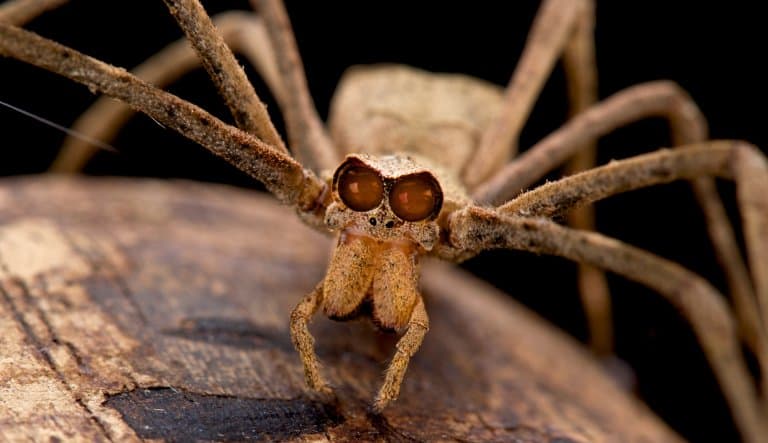
Its two forward-facing eyes are truly enormous and are the largest of any spider. These terrifying peepers have great night vision, and this is what sets them apart from other web-building spiders.
While most web-based ambush spiders use vibrations to pick up their victims, ogre-faced spiders do it all by sight. The visual acuity in their rear-facing eyes is 2000 times as sensitive to light than jumping spiders’, who have excellent day vision.
Holding a net with their front legs, these spiders lunge at passing invertebrates, snaring them, wrapping them up and biting them repeatedly. 4
6. Owls
Owls have enormous eyes. The eyeballs of a tawny owl are bigger than that of humans, despite the bird being 100th of the mass. These eyes have evolved, like the Tarsier’s, to collect plenty of information in the low light of the night and twilight hours.

These eyes give exceptional resolution in low light, at the cost of taking up 5% of the animal’s body weight, and the majority of the space in its skull. Consequently, owls are no better than tarsiers at remembering where they put their keys and are a poor representation of avian intelligence.
Because the owl’s eyes are so long, they can’t swivel, and the bird has instead evolved to be able to turn its head 270 degrees. 5
5. Horses
A horse’s eyes are some of the largest of any land animal, and unlike every animal on this list so far, they’re defensively positioned, rather than binocular.
The bulging nature and lateral position of these huge balls give the animal an incredible 340° visual range, with 65° binocular vision.
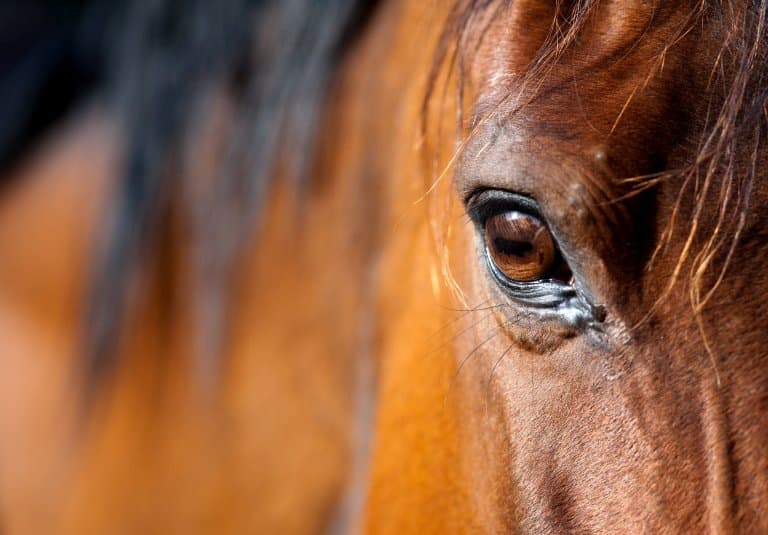
Such a panoramic visual field is why that 1° blind spot is so unsettling for the horse, and why you’re likely to get a kicking if you approach from within it.
Horse vision is a healthy mix of everything. Monocular vision is fantastic at picking up on stalkers, and binocular vision allows them to discern objects in 3D both close and far away. 6
4. Ostriches
Ostrich eyes are not nearly the best in the avian order, but they are some of the largest.
Like the owls’, these bulbous orbs have evolved to be highly sensitive in the dark, and so they don’t have nearly the daylight resolution of, say, an eagle’s, but are great at spotting lions hiding in the bush at 3 am.
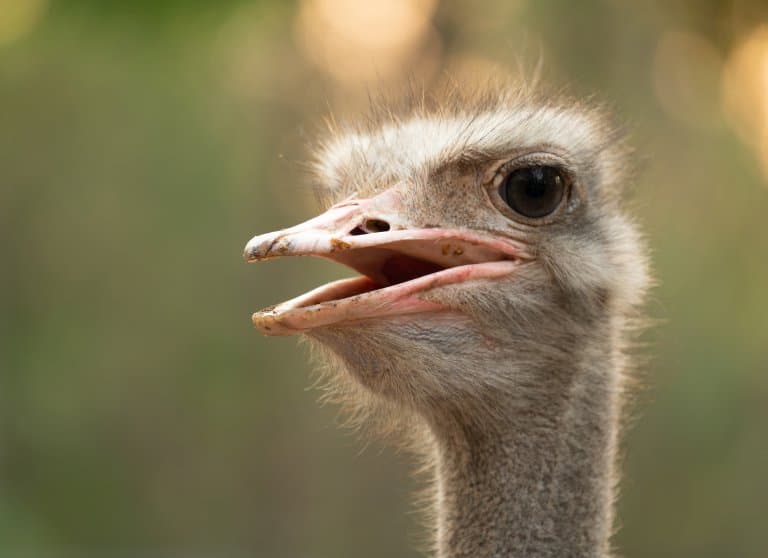
In fact, like many of the animals on this list, ostrich eyes are used as an example of how eyeball size is almost always associated with low-light adaptation, and not usually related to high-res daytime vision. 7
3. Swordfish
Swordfish eyes are not only huge but also heated. The musculature that originally evolved to swivel the eyeball has been adapted as a generator, allowing the eyeball to stay more than 10°C higher than the ambient temperature.
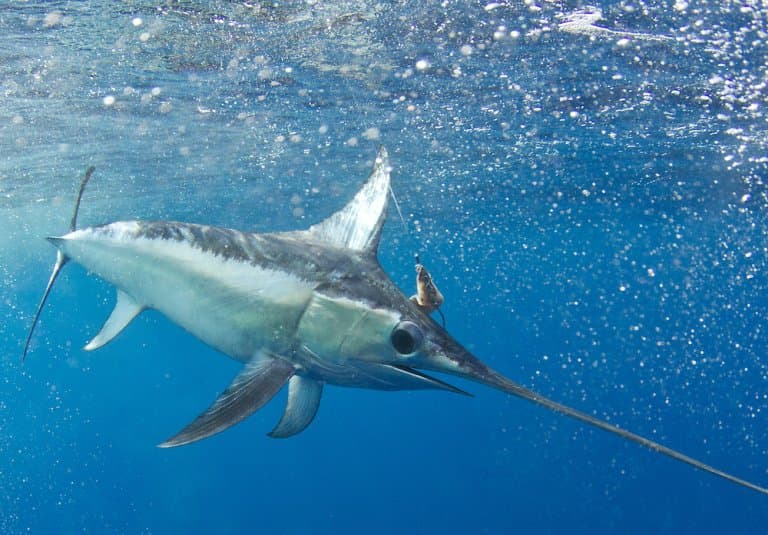
The benefit of having hot eyes is that distant flickers of light register more than 10 times faster than those kept at the temperature of the deep water, and this acts like a high shutter speed, registering fast-moving prey shimmering in the darkness.
It also means that food items like squid and deep-water fish who don’t have this ability can’t register the lightning-fast approach of this powerful predator. 8
2. Vampire Squid
We’ll be staying in the deep for the remainder of this list because this is the darkest place on Earth, and as we’ve discovered, large eyes are an adaptation to dark environments.
As such, the animal with the largest eyes, relative to its body size is the vampire squid. This isn’t a squid, nor is it a vampire, but a distinct order of cephalopod, known as the Vampyromorphida.
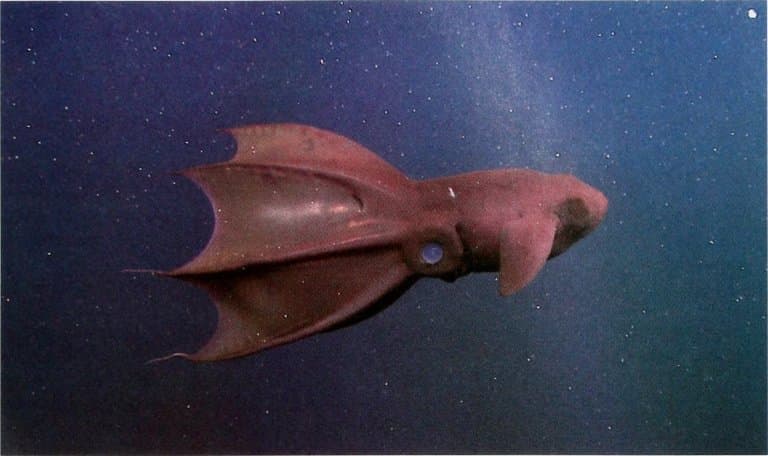
This abyssal mollusc has huge optic lobes to match its large, cloudy eyeballs, which have adapted to pick up on bioluminescent signatures in the inky blackness of water that is so deep, that sunlight never touches it.
It also has its own bioluminescence, which it uses in place of the more familiar ink defence found in other cephalopods: glow-in-the-dark mucous can be ejected as a distraction while it disappears into the shadows. 9
1. Colossal Squid
A distant cousin of the vampire squid has the largest eyes in the animal kingdom and possibly the largest that have ever existed.
The colossal squid is an elusive monster, weighing over 500kg, despite having no skeleton. If its shallower-water relatives are anything to go by, it might also be highly intelligent, but since it spends all its time at depths of a kilometre or more, we know very little about it.
What we do know is that its dinner-plate-sized eyeballs are surrounded by bioluminescent headlamps and give the animal binocular vision in the dark. It’s unlikely this giant can see in colour, but they are likely to be well suited to hunting in the dark, and may even be adapted for spotting the faint silhouette of sperm whales, descending from the surface.
Unfortunately, most of the research on these mysterious giants comes from half-decayed carcasses, washed up on the shore, so there are still plenty of mysteries surrounding the colossal squid to be unravelled. 10
Final Thoughts
That completes our list of animals with huge eyes. Large eyes are predominantly used to gather more light. They’re not usually the best resolution and often don’t need to allow colour vision, but they’re great for condensing tiny slithers of dim light onto a sensitive retina.
As such, most of the animals with the largest eyes are nocturnal. But this is where the major similarities end. Eyes have adapted independently across multiple phyla, with evolution carving out similar adaptations to similar problems, creating organs that serve similar purposes in slightly different ways.
And evolution is an ongoing process. There is no “perfect” in nature, only “optimal”, so there’s plenty of room for improvements as conditions change.
And as predators develop better and better vision to hunt down prey, their victims are forced to keep up with more refined defensive visual organs to escape them.
This evolutionary arms race will continue for as long as there is life on Earth, and perhaps one day, people who work at computer screens all day won’t need to wear glasses.
Fact Sources & References
- Catherine Brahic (2015), “Dragonfly eyes see the world in ultra-multicolour“, New Scientist.
- Michael Marshall (2010), “Zoologger: A primate with eyes bigger than its brains“, New Scientist.
- “Frog Eyes“, American Museum of Natural History.
- “Ogre-faced spider“, University of Florida.
- “Eyes and Vision“, World of Owls.
- Kirk N. Gelatt (2022), “Eye Structure and Function in Horses“, MSD Manual.
- G.R. Martin, D. Osorio (2008), “Ostrich“, The Senses: A Comprehensive Reference.
- Michael Hopkin (2005), “Swordfish heat their eyes for better vision“, Nature.com.
- Wen-Sung Chung et al (2022), “Comparative brain structure and visual processing in octopus from different habitats“, Cell.com.
- Mera McGrew (2012), “The Biggest Eyes in the Animal Kingdom“, Mission Blue.
